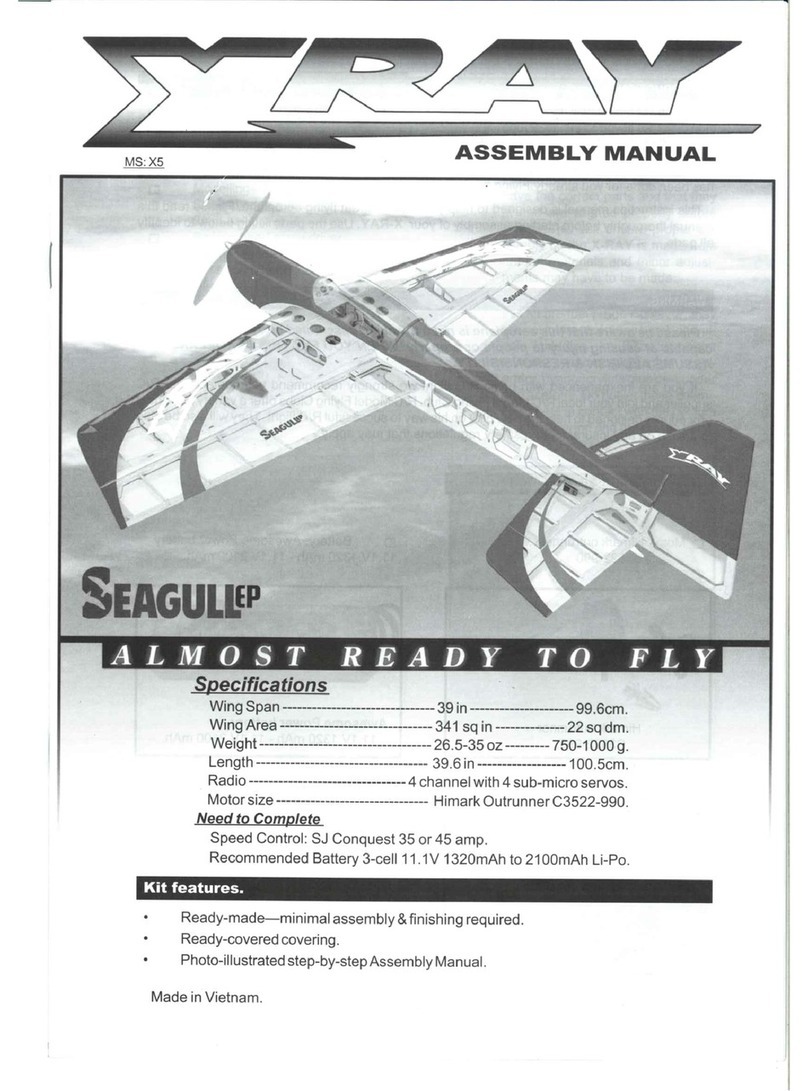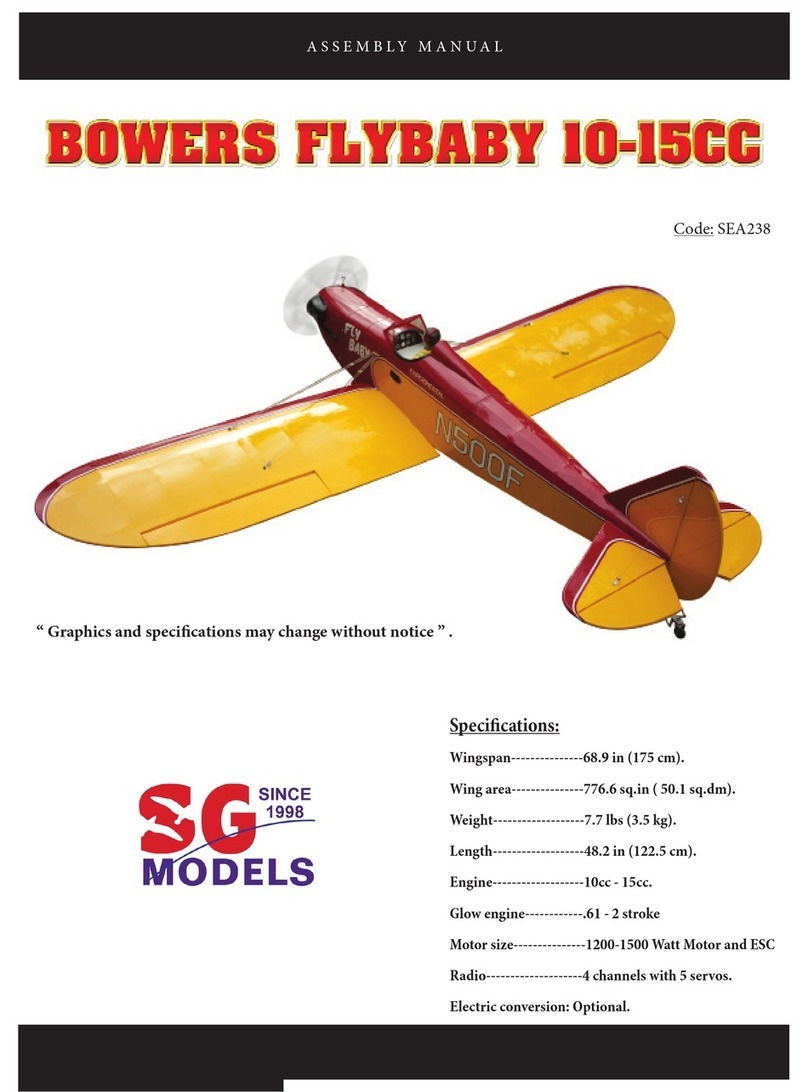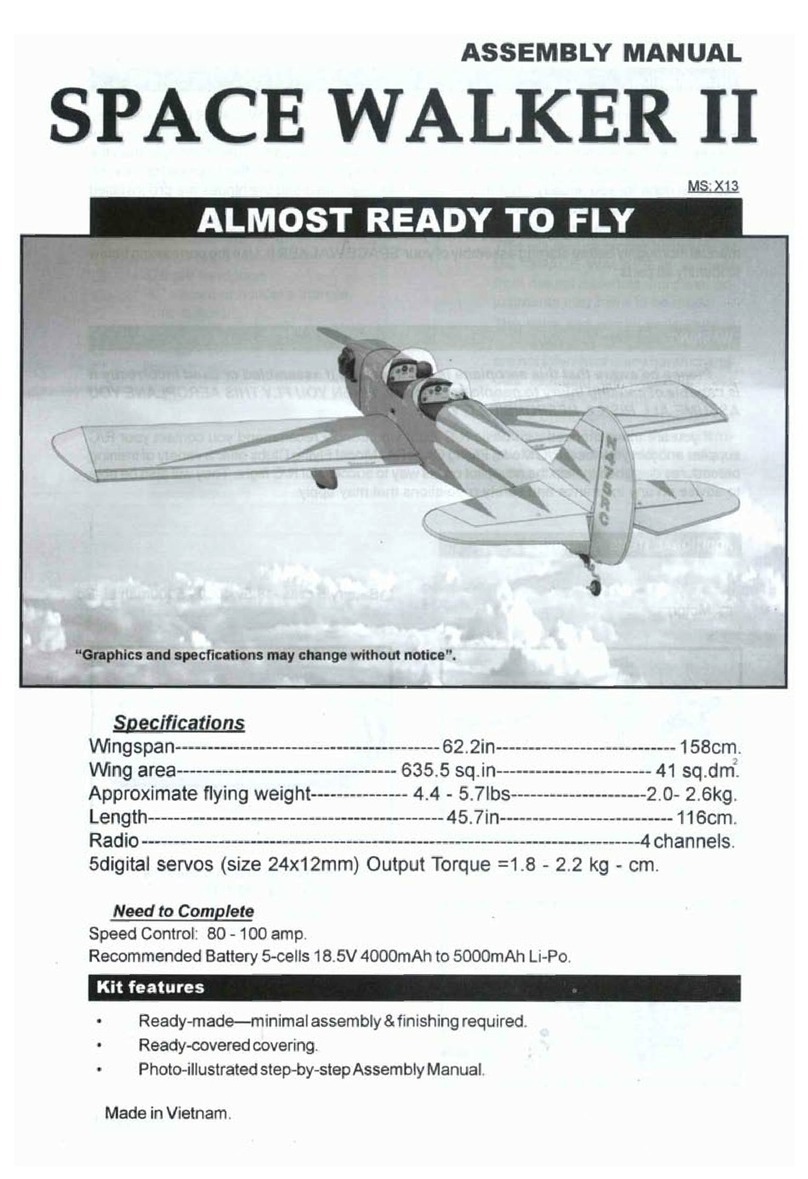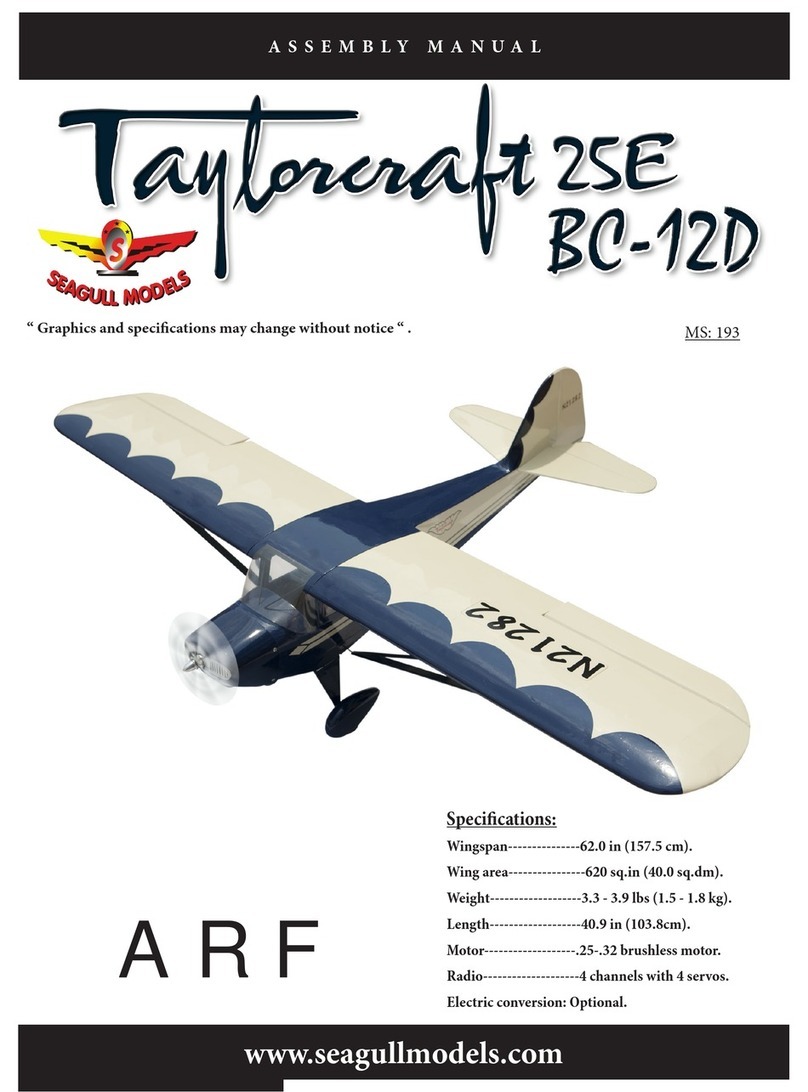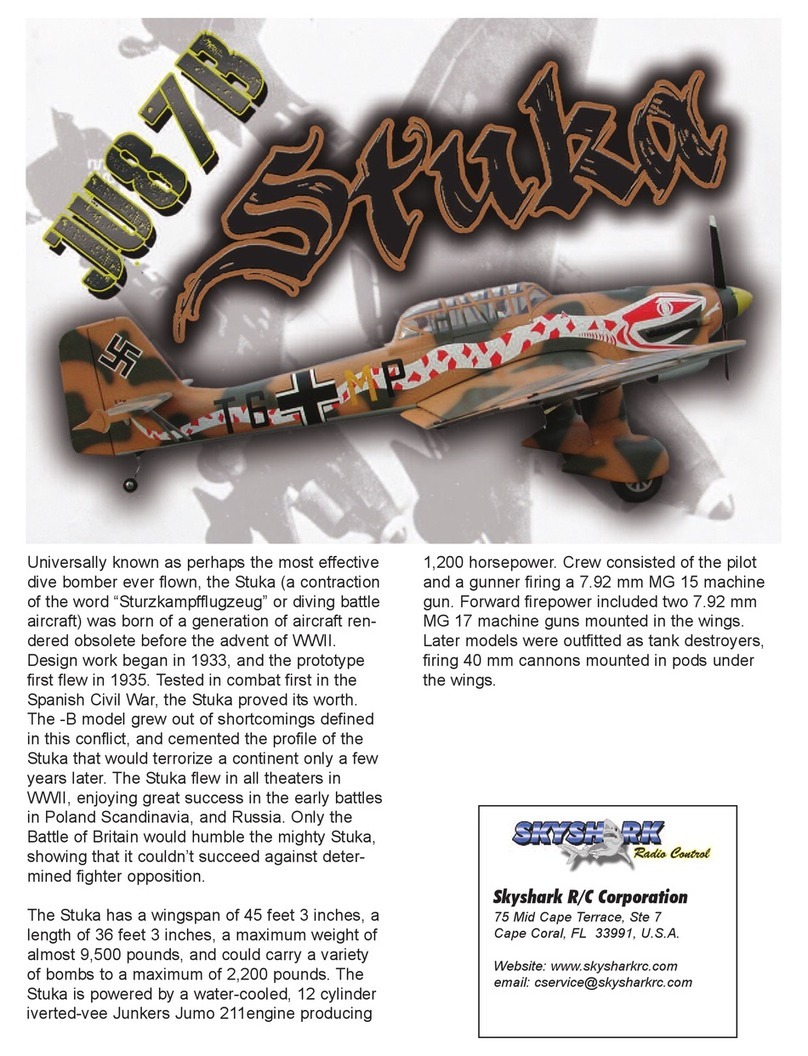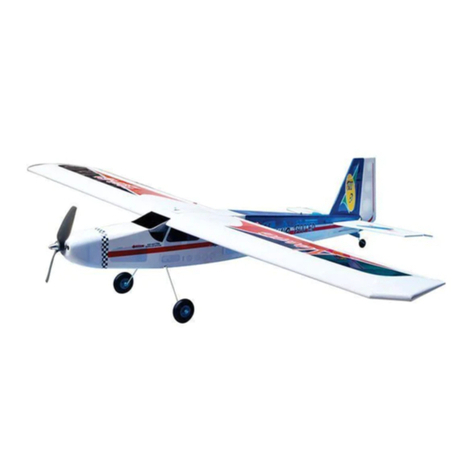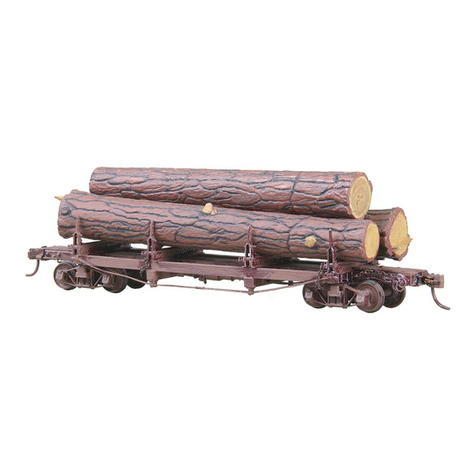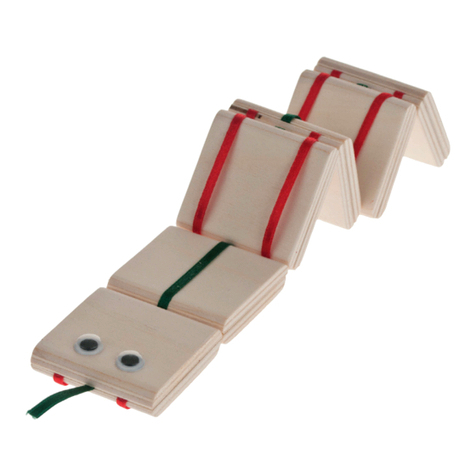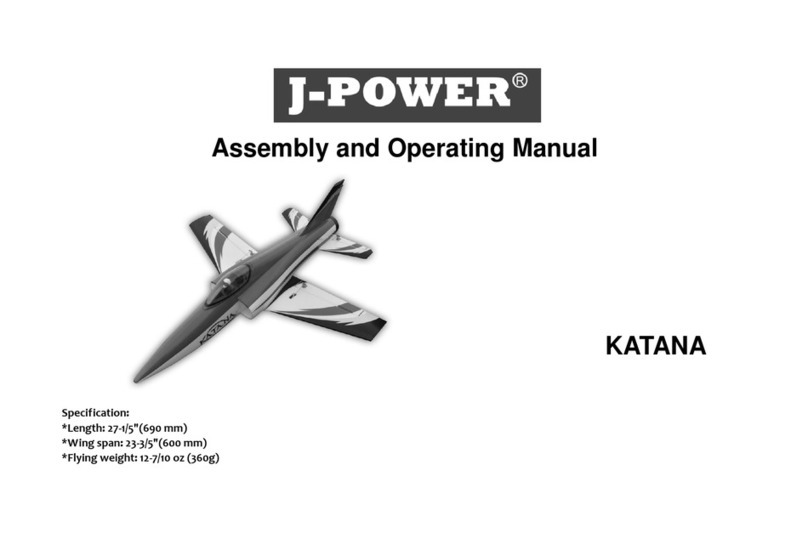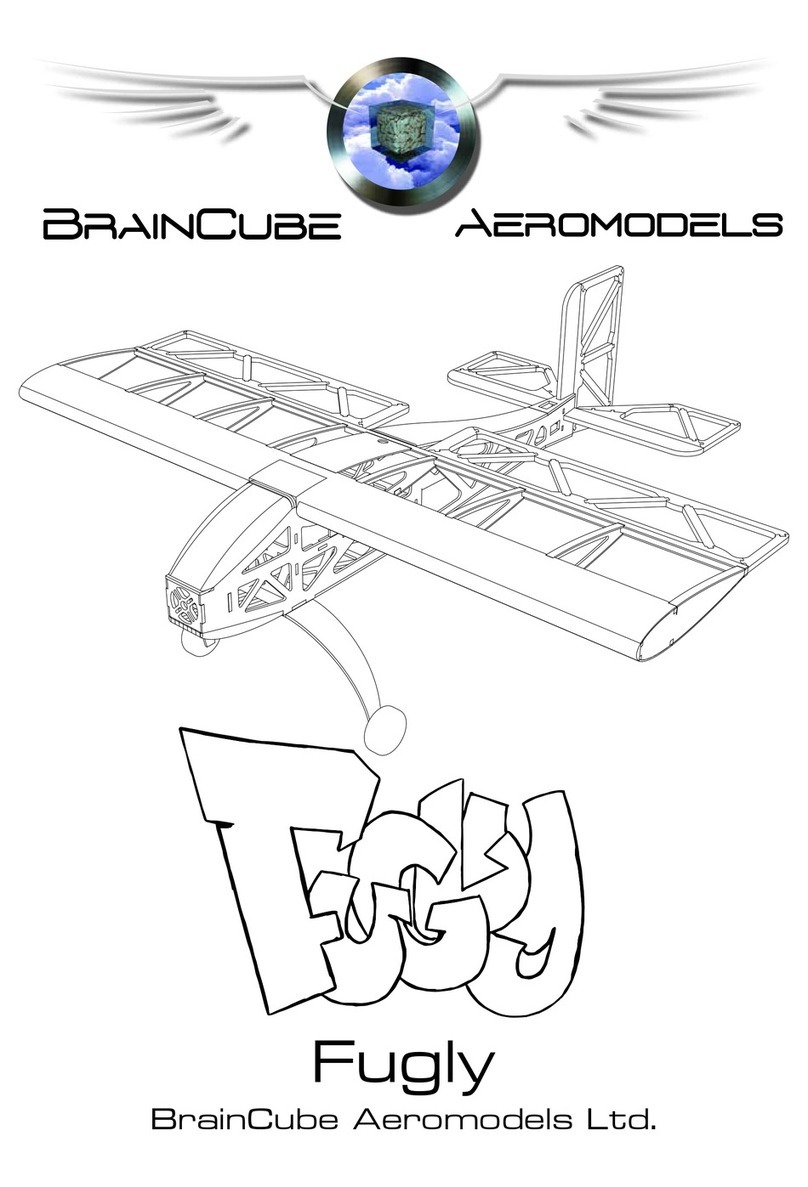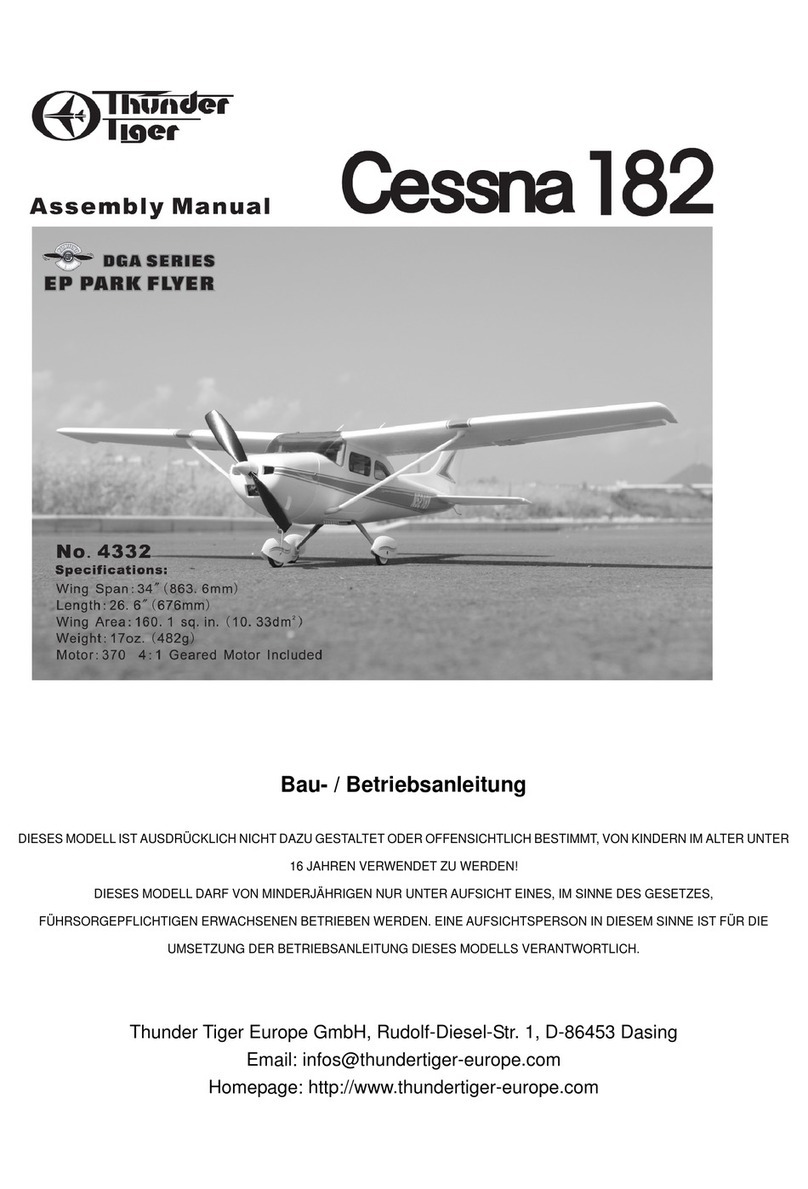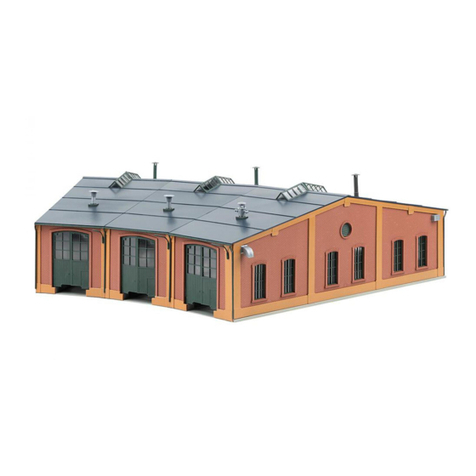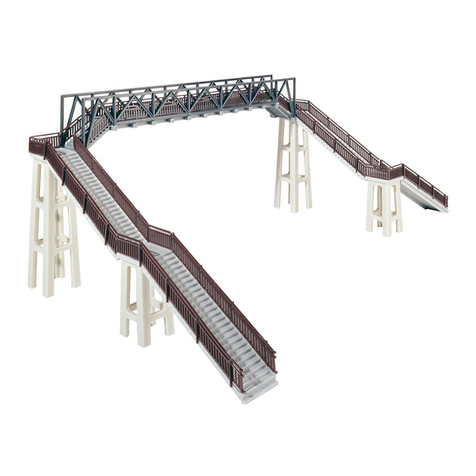Seagull SEA53B User manual

Kit features.
• Ready-made—minimalassembly&finishingrequired.
• Ready-coveredcovering.
• Photo-illustratedstep-by-stepAssemblyManual.
MadeinVietnam.
Specifications
Wing span--------------------------------- 63.4 in --------------------- 161cm.
Wing area-------------------------------- 846 sq.in ------------- 54.6 sq.dm.
Weight-------------------------------------8.4-9.9lbs---------------3.8-4.5kg.
Length-------------------------------------61.4in----------------------156cm.
Recommended engine size---------- .91-1.25 cu.in --------- 2-4stroke.
20cc gasoline engine.
Radio System required 6 channel with 6 digital servos.
FlyingskilllevelIntermediate/advanced.
MS: 53.
“Graphics and Specifications may change without notice”.
A S S E M B L Y M A N U A LA S S E M B L Y M A N U A L
A S S E M B L Y M A N U A LA S S E M B L Y M A N U A L
A S S E M B L Y M A N U A L

YAK 54. Instruction Manual.
2
INTRODUCTION.
Thank you for choosing the YAK 54 ARTF by SG MODELS . The YAK 54 was designed with
the intermediate/advanced sport flyer in mind. It is a semi scale airplane which is easy to fly and
quick to assemble. The airframe is conventionally built using balsa, plywood to make it stronger than
the average ARTF, yet the design allows the aeroplane to be kept light. You will find that most of the
work has been done for you already.Flying the YAK 54 is simply a joy.
This instruction manual is designed to help you build a great flying aeroplane. Please read this
manual thoroughly before starting assembly of your YAK 54. Use the parts listing below to identify
all parts.
WARNING.
Please be aware that this aeroplane is not a toy and if assembled or used incorrectly it is
capable of causing injury to people or property. WHEN YOU FLY THIS AEROPLANE YOU
ASSUME ALL RISK & RESPONSIBILITY.
If you are inexperienced with basic R/C flight we strongly recommend you contact your R/C
supplier and join your local R/C Model Flying Club. R/C Model Flying Clubs offer a variety of training
procedures designed to help the new pilot on his way to successful R/C flight. They will also be able
to advise on any insurance and safety regulations that may apply.
ADDITIONAL ITEMS REQUIRED.
.91-1.25 2-4 stroke engine.
20cc gasoline engine.
Computer radio with six digital
servos.
Glow plug to suit engine.
Propeller to suit engine.
Protective foam rubber for radio
system.
Silicone fuel line.
TOOLS & SUPPLIES NEEDED.
Thick cyanoacrylate glue.
30 minute epoxy.
5 minute epoxy.
Hand or electric drill.
Assorted drill bits.
Modelling knife.
Straight edge ruler.
2mm ball driver.
Phillips head screwdriver.
220 grit sandpaper.
90° square or builder’s triangle.
Wire cutters.
Masking tape & T-pins.
Thread-lock.
Paper towels.
PARTS LISTING.
FUSELAGE ASSEMBLY
(1) Fuselage.
(1) Canopy hatch.
WING ASSEMBLY
(1) Right wing half/ aileron.
(1) Left wing half/ aileron.
(1) Aluminium dihedral brace.
Tail section assembly
(1) Horizontal stabilizer/ elevator
halves.
(1) Rudder halves.
Some more parts.
HARDWARE PACK
COWLING
Landing gear.....

3
The control surfaces, including the
ailerons, elevators, and rudder, are
prehinged with hinges installed, but the
hinges are not glued in place. It is
imperativethatyou properly adherethe
hingesinplaceper thesteps thatfollow
using a high-quality thin C/A glue.
1)Carefully remove theaileron from oneof
thewingpanels.Notethepositionofthehinges.
2)Removeeach hingefromthe wing panel
and aileron and place a T-pin in the center of
each hinge. Slide each hinge into the wing
panel until the T-pin is snug against the wing
panel. This will help ensure an equal amount
ofhingeis on eithersideof the hingelinewhen
the aileron is mounted to the aileron.
HINGING THE AILERONS.
Note:
3) Slide the wing panel on the aileron until
there is only a slight gap. The hinge is now
centered on the wing panel and aileron.
Remove the T-pins and snug the aileron
against the wing panel.A gap of 1/64” or less
shouldbe maintainedbetween the wingpanel
andaileron.
T-pin.
4)Deflect the aileron and completely
saturate each hinge with thin C/A glue. The
aileronsfrontsurface should lightlycontactthe
wing during this procedure. Ideally, when the
The hinge is constructed of a special
material that allows the C/A to wick or
penetrateanddistribute throughoutthe
hinge, securely bonding it to the wood
structureof thewing panel andaileron.
hinges are glued in place, a 1/64” gap or less
will be maintained throughout the lengh of the
aileron to the wing panel hinge line.
Note:
T-pin.
5)Turnthe wingpanel over anddeflect the
aileron in the opposite direction from the
opposite side. Apply thin C/A glue to each
hinge,makingsurethattheC/Apenetratesinto
both the aileron and wing panel.
6)UsingC/Aremover/debonderandapaper
towel, remove any excess C/A glue that may
haveaccumulatedon the wingorin the aileron
hingearea.
To avoid scratching your new aero-
plane we suggest that you cover your work-
benchwith anold towel. Keep a coupleof jars
orbowlshandytoholdthesmallpartsafteryou
open the bags.
Pleasetrialfitallparts.Makesureyouhavethe
correct parts and that they fit and are aligned
properlybeforegluing!Thiswillensureproper
assemblyasthe YAK54 ismadefromnatural
materialsandminor adjustments mayhaveto
be made. The paint and plastic parts used
inthiskit are fuelproof.However, they arenot
tolerant of many harsh chemicals including
thefollowing:paintthinner,cyano-acrylateglue
accelerator,cyanoacrylategluede-bonderand
acetone. Do not let these chemicals come in
contact with the colours on the covering and
the plastic parts.
NOTE:
Hinge.
Hinge.
C/Aglue.
Hinge.

YAK 54. Instruction Manual.
4
Work the aileron up and down several
times to “work in” the hinges and check
for proper movement.
Note: HINGING THE RUDDER.
Glue the rudder hinges in place using the
same techniques used to hinge the ailerons.
Aileron control horn: See pictures below.
AILERON CONTROLHORN
3x20mm.
TURNBUCKLE INSTALLATION.
Thehole locationofturnbucklesshown in pic-
ture below .
The mounting holes of turnbuckle was
pre-drilled at factory.
Installingthe turnbucklefor tailstrut ofhori-
zontal fin as same as pictures below.
8)Afterbothailerons are securely hinged,
firmly grasp the wing panel and aileron to
make sure the hinges are securely glued and
cannot be pulled out. Do this by carefully
applying medium pressure, trying to separate
the aileron from the wing panel. Use caution
not to crush the wing structure.
7) Repeat this process with the other wing
panel, securely hinging the aileron in place.
Horizontal fin bottom.
Turnbuckle.
Tail fin bottom.
2 sets.
3x45mm.
Hinge.
HINGING THE ELEVATOR.
Glue the elevator hinges in place using the
same techniques used to hinge the ailerons.

5
ELEVATOR CONTROL HORN.
M3LOCK
NUT.
ALUMINUMWASHER.
ALUMINUMWASHER.
CONTROLHORN
M3 SCREW.
16mm.
Epoxy.
Wing
Epoxy.
Wing
Install the elevator control horn using the
same method as with the aileron control
horns. Rudder control horn:
Using the same techniques used aileron
control horn. See picture below.
16mm.
Epoxy.
RUDDER CONTROL HORN.
Horizontal
Stabilizer.
2 sets.
3x40mm.
AluminumWasher.
CONTROL HORN M3
Epoxy.
AluminumWasher.
Aileron.
Wing bottom.
M3LOCKNUT.
Elevator control horn.
3 x 60mm.

YAK 54. Instruction Manual.
6
1) Using a modeling knife, carefully cut
off the rear portion of one of the 3 nylon tubes
leaving 1/2” protruding from the rear of the
stopper. This will be the fuel pick up tube.
2) Usinga modelingknife, cutone length
ofsilicon fuel line. Connectone endofthe line
tothe weightedfuel pickup and theother end
to the nylon pick up tube.
3) Carefully bend the second nylon tube
up at a 45º angle. This tube is the vent tube.
INSTALLING THE STOPPER ASSEMBLY.
ENGINE MOUNT.
See pictures below:
Mark and drill 4 holes for engine mount.
4x30mm.
Threadlocker glue.
Diameter=5.5mm.
Rudder control horn.
Fuselage.
Fuselage.
AluminumWasher.
CONTROL HORN M3
M3LOCK NUT.
AluminumWasher.
M3LOCK NUT.
AluminumWasher.
M3LOCK NUT.CONTROL HORN M3
20mm.
Rudder.
Hinge.

7
Balsa wood.
Venttube.
FuelPick-upTube.
FuelFill Tube.
Carefully use a lighter or heat gun to
permenently set the angle of the vent tube.
Important: When the stopper assembly is
installed in the tank, the top of the vent tube
should rest just below the top surface of the
tank. It should not touch the top of the tank.
4) Test fit the stopper assembly into the
tank. It may be necessary to remove some of
the flashing around the tank opening using a
modeling knife. If flashing is present, make
sure none falls into the tank.
5) With the stopper assembly in place,
the weighted pick-up should rest away from
therear of thetank and movefreely inside the
tank. The top of the vent tube should rest just
below the top of the tank. It should not touch
the top of the tank.
6) When satisfied with the alignment of
thestopperassemblytightenthe3mmx20mm
machine screw until the rubber stopper ex-
pands and seals the tank opening. Do not
overtighten the assembly as this could cause
the tank to split.
FUELTANK INSTALLATION.
You should mark which tube is the vent
and which is the fuel pickup when you attach
fuel tubing to the tubes in the stopper. Once
thetank isinstalled insidethe fuselage,it may
be difficult to determine which is which.
Rubber band.
Balsa wood.
Fueltank.

YAK 54. Instruction Manual.
8
3) A drop of C/A glue on the wheel collar
screws will help keep them from coming lose
duringoperation.
Repeat the process for the other wheel.
Lockerglue.
M3. 1) The blind nuts for securing the landing
gearare already mountedinside thefuselage.
INSTALLING THE MAIN LANDING GEAR.
wheel Pant.
wheel.
M3.
wheel collar.
nut. Axle.
Washer.
LandingGear. wheel Pant.
wheel collar.
wheel.
Axle.
Washer.
Lite-Plywood
block.
Lite-Plywood
block.
2) Follow diagram below for wheel pant
installation:
14mm.
7mm.
C/Aglue.
Blow through one of the lines to ensure
the fuel lines have not become kinked inside
the fuel tank compartment. Air should flow
through easily.
Fuel pick-up
tube. Fuelfill tube.
Vent tube.
1) Assembleand mounting the wheelpants
as shown in the following pictures.
WHEEL AND WHEEL PANTS.

9
3) Remove the engine. Using an drill bit,
drill the mounting holes through the engine
mount at the four locations marked.
4) Boltthe engine to theenginemountusing
the four machine screws. Double check that
all the screws are tight before proceeding.
140mm.
Machine Screw 4x30mm.
Engine 2 stroke:
Engine 4 stroke:
1) Place your engine onto the engine
mount. Adjust the engine is centered of the
edges of the engine case.
2) When you are satisfied with the align-
ment, mark the locations of the engine
mounting.
MOUNTING THE ENGINE.
2) Usingthe hardwareprovided, mount the
main landing gear to the fuselage.
M6 X 20mm.
Pushrod wire.
Pushrod wire.
Machine Screw 4x30mm.
4.2mm diameter.

YAK 54. Instruction Manual.
10
Trim and cut.
1.5mm wire
(needlevalve).
Trim and cut.
Markpoint.
Machine Screw 3x10mm.
1mm drill bit.
Paper tape guide.
COWLING.
Markpoint.
Paper tape guide.

11
Engine 4 stroke:
Servo tray.
C/Aglue.
Rudder
servo.
Throttle servo.
INSTALLING THE FUSELAGE SERVO.
Throttle servo.
Rudder servo.
Engine 2 stroke:
1) Locateandcutout thecoveringfilmfrom
the servo holes in both sides of fuselage.
2) Installthe rubbergrommets andbrass
collets onto the elevator servo. Test fit the
servo into the elevator servo mount.
Because the size of servos differ, you
mayneedtoadjust the sizeoftheprecut open-
ing in the mount. The notch in the sides of the
mount allow the servo lead to pass through.
ELEVATOR SERVO INSTALLATION.
3)Secure theservos withthe screws pro-
vided with your radio system.
Left side.
Remove
covering.
INSTALLING THE SWITCH.
Installthe switch intothe precuthole in the
side of the fuselage.
Rightside.
Elevator servo.
Left side.
Elevator servo.

YAK 54. Instruction Manual.
12
Remove covering.
Covered wood
filler piece.
Removecovering.
Pen.
When cutting through the covering to
remove it, cut with only enough pressure to
only cut through the covering itself. Cutting
into the balsa structure may weaken it.
Switch.
HORIZONTALSTABILIZER.
Center line.
Switch.
Remove covering.
Covered wood filler piece.

13
VERTICAL STABILIZER INSTALLATION.
Hingeslot.
Pen.
When cutting through the covering to re-
move it, cut with only enough pressure
toonly cut through the coveringitself. Cutting
into the balsa structure may weaken it.
C/Aglue.
Remove
covering.
INSTALLING THE AILERON SERVOS.
Servos. Smallweight.
Thread.
Rudder control horn.
Hinge.
Epoxy.

YAK 54. Instruction Manual.
14
Attach the string to the servo lead and carefully thread it though the wing.
String. Small Weight.
Wing. Wing rib.
String.
Small Weight.
Aileron.
Wing.
Wing.Aileron.
AILERONPUSHROD HORN INSTALLATION
Wing.
Aileron.
M3 lock nut.
M3clevis.
65mm.
92mm.
String.
Small weight.
Electric wire.
Aileron
Servo.

15
Elevator control horn.
Rudder control horn.
Wing.
Aileron.
M3lock nut.
Control horn.
Elevator Pushrod.
Metalclevis.
M3lock nut. Install servos arm to servos. Notice the posi-
tion of the servo arms on the servos. See
picture below.
See pictures below.
M3lock nut.
Cable wire.
RUDDER PULL - PULL CABLE SYSTEM.
ELEVATOR PUSHROD INSTALLATION.
Elevator pushrods assembly follow pictures
below.
M3 lock nut.
M3clevis.
120mm.
142mm.
Rudder
servo.
Pull - Pull
cable system.

YAK 54. Instruction Manual.
16
1
22
1
70mm.
M3x10mm.
Alumium
trap.
Fuselage bottom.
Bottom.
1
22
M3x10cm(2pcs).
Alumium trap.
Bottom.
70mm.
180mm.
7mm.
Snapkeeper.
INSTALLING TAIL STRUT SUPPORT
The tail strut system assembly follow pic-
tures below.
HorizontalFin.
Vertical Fin.
Rudder pushrod.
Elevator pushrod.
Rudder.
Throttle.

17
2
21
1
HorizontalFin.
Vertical Fin.
M3x25mm.
MOUNTING THE TAIL WHEEL.
Seepicturebelow.
M3x30mm.
M3x25 mm.
M3x30 mm.
Tail landinggear.
Spring.
1
2
M3x30 mm.

YAK 54. Instruction Manual.
18
1) Plug the six servo leads and the switch
lead into the receiver. Plug the battery pack
lead into the switch also.
2) Wrap the receiver and battery pack in
the protective foam rubber to protect them
from vibration.
INSTALLING THE BATTERY-RECEIVER.
3) Route theantennain the antennatube
inside the fuselage and secure it to the bot-
tom of fuselage using a plastic tape. See pic-
ture below.
Antenna.
Antennawire.
Tie wrap.
Receiver.
ATTACHMENT WING-FUSELAGE.
Attach the aluminium tube into fuselage.
Throttle.
Wing tube.
Because the size of servos differ, you
may need to adjust the size of the precut
opening in the mount. The notch in the sides
of the mount allow the servo lead to pass
through.
2) Installthe rubbergrommets andbrass
colletsonto thethrottleservo. Testfit theservo
into the throttle servo mount.
THROTTLE SERVO ARM
INSTALLATION.
1) Installadjustable servo connectorinthe
servo arm.
AdjustableServo
connector.
Servoarm.
3) Secure the servos with the screws pro-
vided with your radio system.
4) Install the pushrod throttle.

19
Insert two wing panels as pictures below. BALANCING.
Wing bolt.
2) If the nose of the plane falls, the plane
is nose heavy. To correct this first move the
battery pack further back in the fuselage. If
this is not possible or does not correct it, stick
small amounts of lead weight on the fuselage
sides under the horizontal stabilizer. If the tail
of the plane falls, the plane is tail heavy. To
correctthis, move thebattery andreceiverfor-
ward orif this is not possible, stick weight onto
thefirewall. When balanced correctly, the air-
plane should sit level or slightly nose down
when you lift it up with your fingers.
M4 x 15mm.
1) It is critical that your airplane be bal-
anced correctly. Improper balance will cause
yourplane to losecontrol and crash. Thecen-
ter of gravity is locate 7-8cm back from the
leading edge of the wing, measured at wing
tip.
CONTROL THROWS.
1) We highly recommend setting up the
YAK 54 using the controlthrows listedat right.
We have listed control throws for both Low
Rate (initial test flying/sport flying) and High
Rate (aerobatic flying).
Wing bolt.
7-8cm.

YAK 54. Instruction Manual.
20
E)Check the throttle. Moving the throttle
stick forward should open the carburetor bar-
rel. Ifitdoesnot,flip the servoreversing switch
on your transmitter to change the direction.
F)From behind the airplane, look at the
ailerononthe rightwinghalf. Move the aileron
sticktotheright. Therightaileronshould move
upand the otheraileron shouldmovedown. If
it does not, flip the servo reversing switch on
your transmitter to change the direction.
5) If your radio transmitter is equipped
withdual rateswitches double checkthat they
are on the low rate setting for your first few
flights.
6) Check to ensure the control surfaces
are moving the proper amount for both low
and high rate settings.
8) Properlybalance thepropeller. An out
of balance propeller will cause excessive vi-
bration which could lead to engine and/or air-
frame failure.
We wish you many safe and enjoyable
flights with your YAK 54.
7) Check the receiver antenna. It should
be fully extended and not coiled up inside the
fuselage.
PREFLIGHT CHECK.
1) Completely charge your transmitter
and receiver batteries before your first day of
flying.
2) Check every bolt and every glue joint
intheYAK 54 to ensurethat everything istight
and well bonded.
3) Double check the balance of the air-
plane. Do this with the fuel tank empty.
4) Checkthe controlsurfaces. All should
move in the correct direction and not bind in
any way.
B) Plug in your radio system per the
manufacturer's instructions and turn every-
thingon.
D) Check the rudder. Looking from be-
hindthe airplane, movethe rudderstick to the
right. Therudder should moveto the right. Ifit
does not, flip the servo reversing switch on
your transmitter to change the direction.
C) Check the elevator first. Pull back on
theelevator stick. Theelevator halvesshould
move up. If it they do not, flip the servo re-
versing switch on your transmitter to change
the direction.
4) By moving the position of the adjust-
able control horn out from the control surface,
you will decrease the amount of throw of that
control surface. Moving the adjustable con-
trol horn toward the control surface will in-
crease the amount of throw.
3) When the elevator, rudder and aileron
control surfaces are centered, use a ruler and
check the amount of the control throw in each
surface. The control throws should be
measured at the widest point of each sur-
face!
FLIGHT PREPARATION.
A) Check the operation and direction of
the elevator, rudder, ailerons and throttle.
2) Turnon the radio system, and with the
trim tabs on the transmitter in neutral, center
the control surfaces by making adjustments
totheclevises oradjustableservo connectors.
The servo arms should be centered also.
INITIAL FLYING/SPORT FLYING
Do not use the aerobatic settings for
initial test flying or sport flying.
Ailerons: 5/8” up 1/2” down
Elevator: 3/4” up 3/4” down
Rudder: 2 1/2” right and left
AEROBATIC FLYING
Ailerons: 1” up 7/8” down
Elevator: 1 1/4” up 1 1/4”down
Rudder: 3 1/2” right and left
Table of contents
Other Seagull Toy manuals
